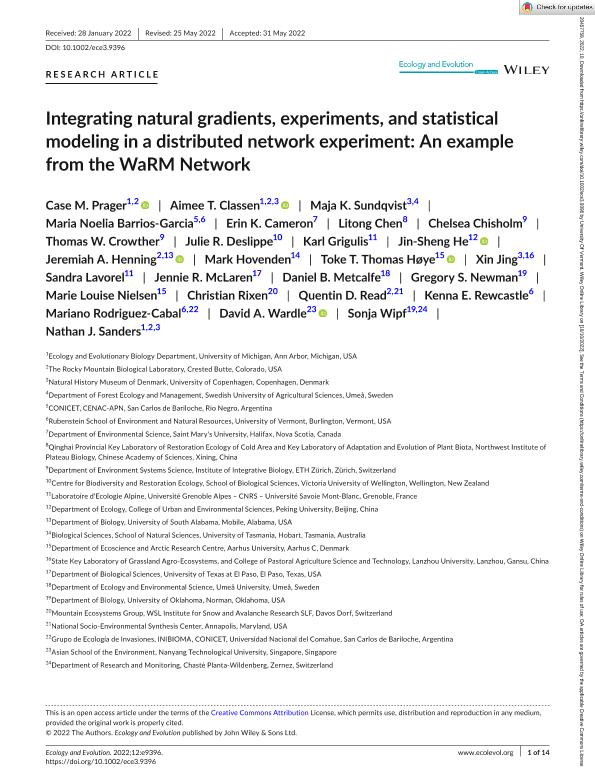Artículo
Integrating natural gradients, experiments, and statistical modeling in a distributed network experiment: An example from the WaRM Network
Prager, Case M.; Classen, Aimee T.; Sundqvist, Maja K.; Barrios Garcia Moar, Maria Noelia ; Cameron, Erin K.; Chen, Litong; Chisholm, Chelsea; Crowther, Thomas W.; Deslippe, Julie R.; Grigulis, Karl; He, Jin Sheng; Henning, Jeremiah A.; Hovenden, Mark; Høye, Toke T. Thomas; Jing, Xin; Lavorel, Sandra; McLaren, Jennie R.; Metcalfe, Daniel B.; Newman, Gregory S.; Nielsen, Marie Louise; Rixen, Christian; Read, Quentin D.; Rewcastle, Kenna E.; Rodriguez Cabal, Mariano Alberto
; Cameron, Erin K.; Chen, Litong; Chisholm, Chelsea; Crowther, Thomas W.; Deslippe, Julie R.; Grigulis, Karl; He, Jin Sheng; Henning, Jeremiah A.; Hovenden, Mark; Høye, Toke T. Thomas; Jing, Xin; Lavorel, Sandra; McLaren, Jennie R.; Metcalfe, Daniel B.; Newman, Gregory S.; Nielsen, Marie Louise; Rixen, Christian; Read, Quentin D.; Rewcastle, Kenna E.; Rodriguez Cabal, Mariano Alberto ; Wardle, David A.; Wipf, Sonja; Sanders, Nathan J.
; Wardle, David A.; Wipf, Sonja; Sanders, Nathan J.
 ; Cameron, Erin K.; Chen, Litong; Chisholm, Chelsea; Crowther, Thomas W.; Deslippe, Julie R.; Grigulis, Karl; He, Jin Sheng; Henning, Jeremiah A.; Hovenden, Mark; Høye, Toke T. Thomas; Jing, Xin; Lavorel, Sandra; McLaren, Jennie R.; Metcalfe, Daniel B.; Newman, Gregory S.; Nielsen, Marie Louise; Rixen, Christian; Read, Quentin D.; Rewcastle, Kenna E.; Rodriguez Cabal, Mariano Alberto
; Cameron, Erin K.; Chen, Litong; Chisholm, Chelsea; Crowther, Thomas W.; Deslippe, Julie R.; Grigulis, Karl; He, Jin Sheng; Henning, Jeremiah A.; Hovenden, Mark; Høye, Toke T. Thomas; Jing, Xin; Lavorel, Sandra; McLaren, Jennie R.; Metcalfe, Daniel B.; Newman, Gregory S.; Nielsen, Marie Louise; Rixen, Christian; Read, Quentin D.; Rewcastle, Kenna E.; Rodriguez Cabal, Mariano Alberto ; Wardle, David A.; Wipf, Sonja; Sanders, Nathan J.
; Wardle, David A.; Wipf, Sonja; Sanders, Nathan J.
Fecha de publicación:
10/2022
Editorial:
John Wiley & Sons
Revista:
Ecology and Evolution
e-ISSN:
2045-7758
Idioma:
Inglés
Tipo de recurso:
Artículo publicado
Clasificación temática:
Resumen
A growing body of work examines the direct and indirect effects of climate change on ecosystems, typically by using manipulative experiments at a single site or performing meta-analyses across many independent experiments. However, results from single-site studies tend to have limited generality. Although meta-analytic approaches can help overcome this by exploring trends across sites, the inherent limitations in combining disparate datasets from independent approaches remain a major challenge. In this paper, we present a globally distributed experimental network that can be used to disentangle the direct and indirect effects of climate change. We discuss how natural gradients, experimental approaches, and statistical techniques can be combined to best inform predictions about responses to climate change, and we present a globally distributed experiment that utilizes natural environmental gradients to better understand long-term community and ecosystem responses to environmental change. The warming and (species) removal in mountains (WaRM) network employs experimental warming and plant species removals at high- and low-elevation sites in a factorial design to examine the combined and relative effects of climatic warming and the loss of dominant species on community structure and ecosystem function, both above- and belowground. The experimental design of the network allows for increasingly common statistical approaches to further elucidate the direct and indirect effects of warming. We argue that combining ecological observations and experiments along gradients is a powerful approach to make stronger predictions of how ecosystems will function in a warming world as species are lost, or gained, in local communities.
Archivos asociados
Licencia
Identificadores
Colecciones
Articulos(INIBIOMA)
Articulos de INST. DE INVEST.EN BIODIVERSIDAD Y MEDIOAMBIENTE
Articulos de INST. DE INVEST.EN BIODIVERSIDAD Y MEDIOAMBIENTE
Citación
Prager, Case M.; Classen, Aimee T.; Sundqvist, Maja K.; Barrios Garcia Moar, Maria Noelia; Cameron, Erin K.; et al.; Integrating natural gradients, experiments, and statistical modeling in a distributed network experiment: An example from the WaRM Network; John Wiley & Sons; Ecology and Evolution; 12; 10; 10-2022; 1-14
Compartir
Altmétricas



